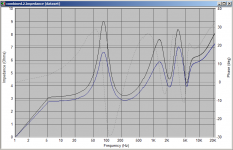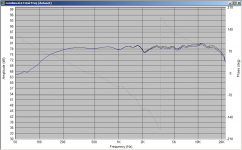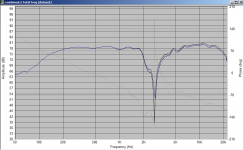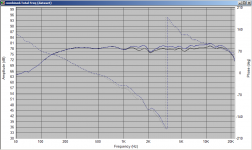Could be, a crossover can be done well at any frequency. The success of a crossover depends on compromises that are specific to the speaker in question. I was asking what problems you have with woofers running at 300Hz as the answer to this gives information needed to cross well.Phoenix358 prefers to allow the woofers to operate up to, say 300Hz, so that the midrange driver is stressed less and can be confined to a narrower frequency band. I prefer to stop the woofer at something like 100Hz because I want the midrange (which is a 6" or 7" midbass driver in my case) to handle the entire range of frequencies of the human voice. Both of these appear sensible trade-offs to me -- they both lose something and get something in exchange.
Last edited:
My problem with woofers at 300Hz is that the same driver cone of the woofer which is being used to reproduce deep bass percussion instruments is also going to be used for male voice. Some woofers may not do a good job with the full details of the male voice in that case. Basically, if the woofer cone is at a point displaced by a large distance from its resting position, and needs to reproduce small signals at other frequencies at that point, there could be muddying of the small-signal reproduction at that point.I was asking what problems you have with woofers running at 300Hz as the answer to this gives information needed to cross well.
Keeping the voice frequencies with one driver and the large-displacement deep bass with a separate driver avoids this. Hence, xo at something below 150Hz.
I used to think the same as you, but eventually I hadn't come to any conclusions other than I wasn't doing it right.
There may be a varying distortion produced with the higher frequencies if the cone is at a different part of its travel but is likely to be low level 2nd harmonic. This distortion shouldn't be significantly noticeable, and shouldn't be enough to ruin the reproduction.
I wouldn't think there is a problem with the hall effect. As an example a 50Hz tone that moves the cone 10mm peak means the cone will move just 2m per second. Furthermore, 20mm is less than 2% of a wavelength at 300Hz.
Cabinet vibrations or inadequate damping, and the change in room reflections when experimenting with different crossover points can also confuse the issue, as can dispersion changes, phase and group delay if this is not tested in a controlled way.
On the other hand, a possible benefit with running the mids through a single driver is that voice coil distortions may be more consistent across that band. It may/may not be significant, but could be attended to in a few ways such as what you're suggesting, or by running the woofer higher instead. It could also be done by ensuring each driver either is fairly well matched or better still, simply doesn't significantly produce this distortion.
It is to this end that I questioned your use of a midbass driver. Some voice coil distortions are not related to how hard the driver is working at the time, and some of the decisions you've made may possibly make these worse. (These are standard compromises where there is no right or wrong answer..just a sensible choice on how far to stretch things).
Ie: moving to a smaller voice coil (Consistency would be less of an issue with a two-way where it handles all the midbass). Furthermore, with reduced efficiency comes a harder working coil...so also the decision to move to a smaller cone, and to use one with an Fc lower than necessary.
There may be a varying distortion produced with the higher frequencies if the cone is at a different part of its travel but is likely to be low level 2nd harmonic. This distortion shouldn't be significantly noticeable, and shouldn't be enough to ruin the reproduction.
I wouldn't think there is a problem with the hall effect. As an example a 50Hz tone that moves the cone 10mm peak means the cone will move just 2m per second. Furthermore, 20mm is less than 2% of a wavelength at 300Hz.
Cabinet vibrations or inadequate damping, and the change in room reflections when experimenting with different crossover points can also confuse the issue, as can dispersion changes, phase and group delay if this is not tested in a controlled way.
On the other hand, a possible benefit with running the mids through a single driver is that voice coil distortions may be more consistent across that band. It may/may not be significant, but could be attended to in a few ways such as what you're suggesting, or by running the woofer higher instead. It could also be done by ensuring each driver either is fairly well matched or better still, simply doesn't significantly produce this distortion.
It is to this end that I questioned your use of a midbass driver. Some voice coil distortions are not related to how hard the driver is working at the time, and some of the decisions you've made may possibly make these worse. (These are standard compromises where there is no right or wrong answer..just a sensible choice on how far to stretch things).
Ie: moving to a smaller voice coil (Consistency would be less of an issue with a two-way where it handles all the midbass). Furthermore, with reduced efficiency comes a harder working coil...so also the decision to move to a smaller cone, and to use one with an Fc lower than necessary.
Understood.I used to think the same as you, but eventually I hadn't come to any conclusions other than I wasn't doing it right.
I guess how well my approach works depends quite a bit on choice of drivers and other factors. So, given my inexperience with various drivers and their behaviour, I thought I'll just try this approach and see. I'm using pretty "similar" drivers for the woofer and the midbass: I'm using Dayton RS metal-cone drivers: 10" and 6".
I've just made the first modification to the crossover that I built back in Oct 2011! This more came out of a realisation (after posting something in another thread) that there was a "mistake" in my crossover. I had put my LPAD shunt resistor before the tweeter filter, thereby lowering the impedance of the speakers seen by the amp across the board down to DC!
After a bit of playing around in speaker workshop it was apparent that the easiest tweak was to simply do away with the shunt resistor altogether. This results in approx 1db increase in higher frequencies but I thought I'd give it a go and see how it sounded. Result is I think it's fine! I've only listened to a couple of Ella and Louis tracks so far but it seems to have brought out some background sounds that I hadn't noticed before. Bonus is that the reverse null is even better than before. From the sim increasing the series resistor from 3 ohms to 3.6 ohms puts it back to almost the same as what it was with the 22 ohm shunt resistor should I find the extra high end too much.
I also had a bit of a play and was able to in the sim get an even flatter response than the existing crossover. This involved changing the caps and coil in the high pass, and tweaking the 1K notch in the low pass.
I've also been playing with a new version with a lower crossover frequency of 2.2Khz using a shunt notch instead of a parallel notch (in series) for the 4K peak, but I've not been able to get as good phase tracking with that as with the parallel notch in series. I realised that the improvement with the 4th order may have been more to do with the 4K peak being squashed better than that the tweeter was struggling, and that a lower tweeter cross may be possibile (and desirable).
I'll keep simming and If I come up with something that looks good I may make another iteration
Pictures are the sims of the changes. Blue is original Black is with the modifications.
1st pic shows the improvement in the impedance, no more dips below 3 ohms!
2nd pic shows the affect on FR. I'm not finding it offensive as yet.
3rd pic shows the improvement in the reverse null.
4th pic shows the tweaked version (revised high pass, revised 1k notch and a slightly bigger LP coil) Not sure whether I would bother making this variation, I think if I can get good phase traking with a 2.2Khz or even 2Khz crossover I might try that.
Tony.
After a bit of playing around in speaker workshop it was apparent that the easiest tweak was to simply do away with the shunt resistor altogether. This results in approx 1db increase in higher frequencies but I thought I'd give it a go and see how it sounded. Result is I think it's fine! I've only listened to a couple of Ella and Louis tracks so far but it seems to have brought out some background sounds that I hadn't noticed before. Bonus is that the reverse null is even better than before. From the sim increasing the series resistor from 3 ohms to 3.6 ohms puts it back to almost the same as what it was with the 22 ohm shunt resistor should I find the extra high end too much.
I also had a bit of a play and was able to in the sim get an even flatter response than the existing crossover. This involved changing the caps and coil in the high pass, and tweaking the 1K notch in the low pass.
I've also been playing with a new version with a lower crossover frequency of 2.2Khz using a shunt notch instead of a parallel notch (in series) for the 4K peak, but I've not been able to get as good phase tracking with that as with the parallel notch in series. I realised that the improvement with the 4th order may have been more to do with the 4K peak being squashed better than that the tweeter was struggling, and that a lower tweeter cross may be possibile (and desirable).
I'll keep simming and If I come up with something that looks good I may make another iteration
Pictures are the sims of the changes. Blue is original Black is with the modifications.
1st pic shows the improvement in the impedance, no more dips below 3 ohms!
2nd pic shows the affect on FR. I'm not finding it offensive as yet.
3rd pic shows the improvement in the reverse null.
4th pic shows the tweaked version (revised high pass, revised 1k notch and a slightly bigger LP coil) Not sure whether I would bother making this variation, I think if I can get good phase traking with a 2.2Khz or even 2Khz crossover I might try that.
Tony.
Attachments
hay tony
does it really sound that much different
dont mean any disrespect but
blind listening between your first xover then now
i sure that the average person wouldnt notice any thing different
i get hung up on the same plain of thought
in reality can we really pick a 20Uf change in caps?
good to see that you are still doing stuff in music listening
it always sooths the () beast
cheers speedie
does it really sound that much different
dont mean any disrespect but
blind listening between your first xover then now
i sure that the average person wouldnt notice any thing different
i get hung up on the same plain of thought
in reality can we really pick a 20Uf change in caps?
good to see that you are still doing stuff in music listening
it always sooths the () beast
cheers speedie
Hi Speedie, 1db at 8 or more Khz should definitely be audible, but I didn't A/B it. The main reason for the change though was to fix the impedance problem (to make life easier for my amp. again 1/2 ohm across the board may not make that much difference, but I'd always felt that with dips as low as 2.7 ohms they were pushing the limit a bit.
As for difference with dropping the crossover freq to 2.2Khz the main thing that should help with is less lobing (from memory), though probably 2Khz would be a better target.
Oh and if by first crossover you mean the very first one in this thread, not just this minor modification then I would say even the most untrained listener would be able to pick the difference fully blind. It was not subtle at all!!
Tony.
As for difference with dropping the crossover freq to 2.2Khz the main thing that should help with is less lobing (from memory), though probably 2Khz would be a better target.
Oh and if by first crossover you mean the very first one in this thread, not just this minor modification then I would say even the most untrained listener would be able to pick the difference fully blind. It was not subtle at all!!
Tony.
I have a mw144 with 30s in a transmission line. The cab is near enough the ipl M3
link: IPL M3TL mk3 Transmission Line
I think it's 8 years since I first posted, looking for help. I think I had probably been at it 8 years then. On and off.
They are OK, with a 2nd order about 2.8khz. It's nothing special though and I have taken many db away from the 30s to improve things. Leaving the tops about as loud as the bass, but a hump between 500hz and 1khz making them sing more than dance. I like dance.
Time change and so have my hobbies. It's electric bikes now. I would like to try some different crossovers though. Just not design them. Are there any designs about that are polished enough to copy with reasonable success?
link: IPL M3TL mk3 Transmission Line
I think it's 8 years since I first posted, looking for help. I think I had probably been at it 8 years then. On and off.
They are OK, with a 2nd order about 2.8khz. It's nothing special though and I have taken many db away from the 30s to improve things. Leaving the tops about as loud as the bass, but a hump between 500hz and 1khz making them sing more than dance. I like dance.
Time change and so have my hobbies. It's electric bikes now. I would like to try some different crossovers though. Just not design them. Are there any designs about that are polished enough to copy with reasonable success?
 discussion from above post split off to http://www.diyaudio.com/forums/multi-way/295584-help-crossover-mw144-tl.html
discussion from above post split off to http://www.diyaudio.com/forums/multi-way/295584-help-crossover-mw144-tl.html- Status
- This old topic is closed. If you want to reopen this topic, contact a moderator using the "Report Post" button.
- Home
- Loudspeakers
- Multi-Way
- My Morel MTM Project



